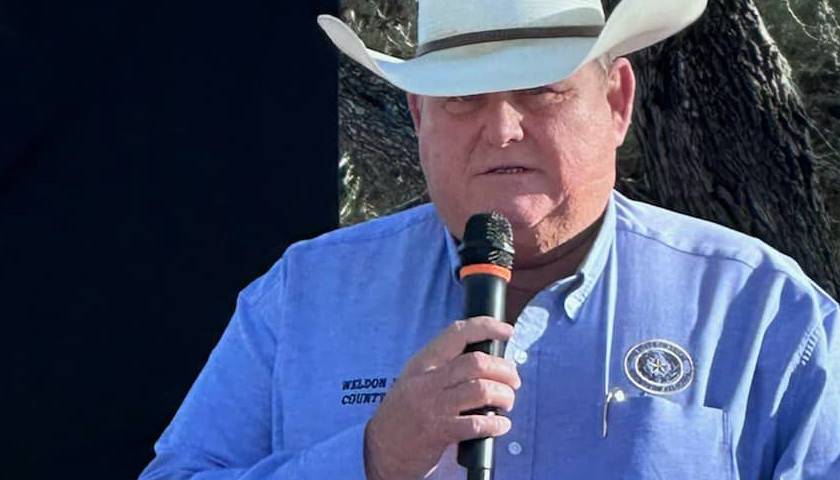by Bethany Blankley
Three years into the border crisis, 50 Texas counties have now declared an invasion.
The latest to do so are the judges and commissioners of Bandera, Schleicher and Uvalde counties. Officials in Bandera and Schleicher counties signed nearly identical resolutions in November as Crockett County’s. Crockett County declared an invasion after its county judge’s family members were killed by an alleged human smuggler. Uvalde County officials signed their invasion resolution in July, when they also joined a coalition led by Atascosa County Judge Weston Cude.

All 50 county resolutions cite the invasion clauses of the U.S. Constitution, Articles IV, Section 4, which require the federal government to protect states from an invasion. They also cite Article IV, Section 7 of the Texas Constitution, which states the governor has the legal authority to command Texas military forces and call them up to “suppress insurrection and to repel invasions.”
They also point to the work of Gov. Greg Abbott’s border security mission, Operation Lone Star, whose officers are interdicting the “smuggling of drugs, weapons, and cartel-trafficked people into Texas,” and working to “prevent, detect, and interdict transnational criminal activity between ports of entry.” The Biden administration created the border crisis, county officials argue, with an estimated 10 million people illegally entering the country since 2021. An unprecedented 1.9 million illegal entered Texas in fiscal 2023 alone, The Center Square exclusively reported.
“The invasion is unsustainable and threatens the lives of our citizens,” officials in these counties maintain. They also express support for border counties, adding that their own non-border communities “cannot absorb the socio-economic costs and criminal impact resulting from … an unsecure and open border.”
When Cude came into office a year ago, he reached out to dozens of judges encouraging their counties to declare an invasion. He also formed a contiguous county coalition to come up with solutions and express support for border counties. Prior to Cude’s election, Atascosa County was among the first to issue disaster and invasion declarations.
“Why wouldn’t you declare an invasion?” Cude asked. “If you have people from all over the world coming into your county by bus, plane, or smuggling people and drugs, why wouldn’t you declare an invasion?”
He and others are calling on Congress to cut funding that’s enabling what they say are Biden’s failed policies. They argue Congress continuing to fund the current “catch and release policy,” releasing millions of people into the U.S. after they illegally entered instead of deporting them, makes Congress complicit in facilitating the border crisis and enabling Mexican cartel activity. Congress’ failure to stop the border crisis is burdening local communities nationwide, they argue.
Cude and other judges agree with Abbott that Texas “didn’t create this crisis” but “Texas is leading on border security and Texans will defend our state and our country.”
“We fought two wars over this border,” Cude said, referring to the Texas Revolution and the Mexican American War. “Texans and Americans died and bled for this border, our state and this country. It is worth defending and we must defend it. Without a border, without enforcing our laws, we don’t have a state or a country.”
The resolutions of Bandera, Crockett, Schleicher and Uvalde counties are similar to those passed by officials in 46 other counties. Kinney, Goliad and Terrell counties were the first to declare an invasion on July 5, 2022.
The 50 counties that have declared an invasion, according to resolutions obtained by The Center Square: Atascosa, Bandera, Burnet, Chambers, Clay, Collin, Crockett, Ector, Edwards, Ellis, Fannin, Franklin, Frio, Goliad, Hamilton, Hardin, Harrison, Hood, Hunt, Jack, Jasper, Johnson, Karnes, Kinney, La Salle, Lavaca, Leon, Liberty, Live Oak, Madison, McMullen, Medina, Montague, Navarro, Orange, Parker, Presidio, Schleicher, Shackelford, Somervell, Terrell, Throckmorton, Tyler, Uvalde, Van Zandt, Waller, Wharton, Wichita, Wilson and Wise.
Some of these counties are among 58 that issued disaster declarations, following Kinney County, after it first issued a disaster declaration on April 21, 2021. Abbott then issued a state disaster declaration for counties on May 31, 2021. Counties that issued disaster declarations agreed to partner with Abbott’s border security efforts, including arresting and detaining people who commit border-related crimes.
They include: Bee, Brewster, Brooks, Caldwell, Cameron, Chambers, Colorado, Crane, Crockett, Culberson, DeWitt, Dimmit, Duval, Edwards, El Paso, Frio, Galveston, Goliad, Gonzales, Hidalgo, Hudspeth, Jackson, Jeff Davis, Jim Hogg, Jim Wells, Kenedy, Kerr, Kimble, Kinney, Kleberg, La Salle, Lavaca, Live Oak, Mason, Maverick, McCulloch, McMullen, Medina, Menard, Midland, Pecos, Presidio, Real, Refugio, San Patricio, Schleicher, Sutton, Terrell, Throckmorton, Uvalde, Val Verde, Victoria, Webb, Wharton, Wilbarger, Wilson, Zapata, and Zavala.
The governor has renewed the state disaster declaration every 30 days, enabling counties “to combat the ongoing influx of unlawful immigrants and authorizes the use of all necessary and available state and local resources to protect landowners in these counties from trespassers and the damage caused to private property,” according to the declaration.
So far, nearly 40 percent of Texas’ 254 counties have issued either disaster or invasion declarations, or both, citing the border crisis.
– – –
Bethany Blankley is a contributor to The Center Square.
Photo “Illegal Aliens Detained” by Texas DPS.





